Peugeot 508 RXH 2014 Owner's Manual
Manufacturer: PEUGEOT, Model Year: 2014, Model line: 508 RXH, Model: Peugeot 508 RXH 2014Pages: 338, PDF Size: 10.81 MB
Page 211 of 338
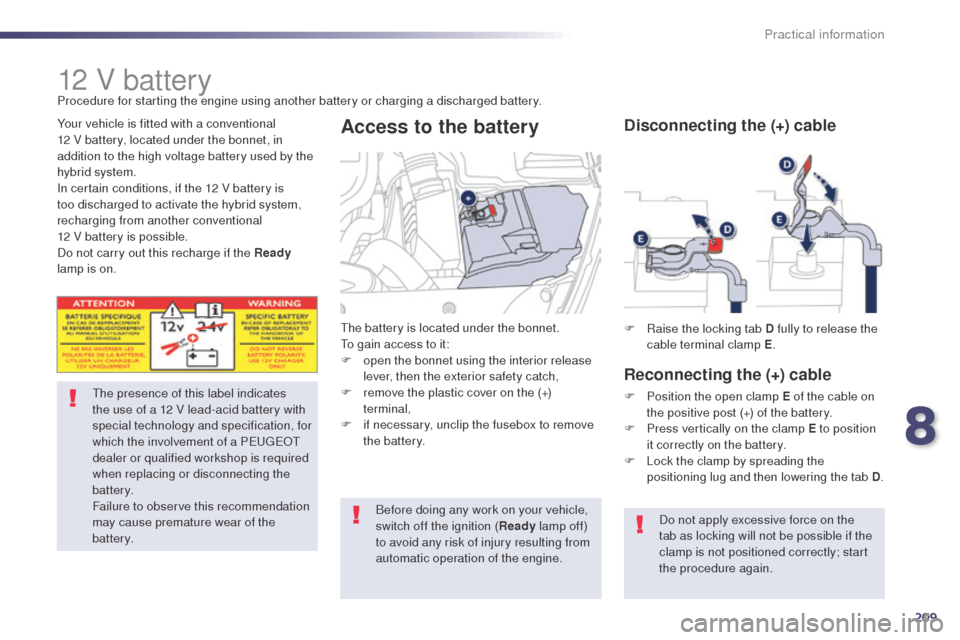
209
508RXH_en_Chap08_info-pratiques_ed01-2014
12 V battery
the presence of this label indicates
the use of a 12 V lead-acid battery with
special technology and specification, for
which the involvement of a P
e
uge
Ot
dealer or qualified workshop is required
when replacing or disconnecting the
battery.
Failure to observe this recommendation
may cause premature wear of the
battery.
th
e battery is located under the bonnet.
to g
ain access to it:
F
o
pen the bonnet using the interior release
lever, then the exterior safety catch,
F r emove the plastic cover on the (+)
terminal,
F
i
f necessary, unclip the fusebox to remove
the battery.
Access to the battery
Before doing any work on your vehicle,
switch off the ignition ( Ready lamp off)
to avoid any risk of injury resulting from
automatic operation of the engine.
Your vehicle is fitted with a conventional
12 V battery, located under the bonnet, in
addition to the high voltage battery used by the
hybrid system.
In certain conditions, if the 12 V battery is
too discharged to activate the hybrid system,
recharging from another conventional
12 V battery is possible.
Do not carry out this recharge if the Ready
lamp is on. Procedure for starting the engine using another battery or charging a discharged battery.
F
Ra
ise the locking tab D fully to release the
cable terminal clamp E .
Disconnecting the (+) cable
Reconnecting the (+) cable
F Position the open clamp E of the cable on
the positive post (+) of the battery.
F
P
ress vertically on the clamp E to position
it correctly on the battery.
F
L
ock the clamp by spreading the
positioning lug and then lowering the tab D .
Do not apply excessive force on the
tab as locking will not be possible if the
clamp is not positioned correctly; start
the procedure again.
8
Practical information
Page 212 of 338
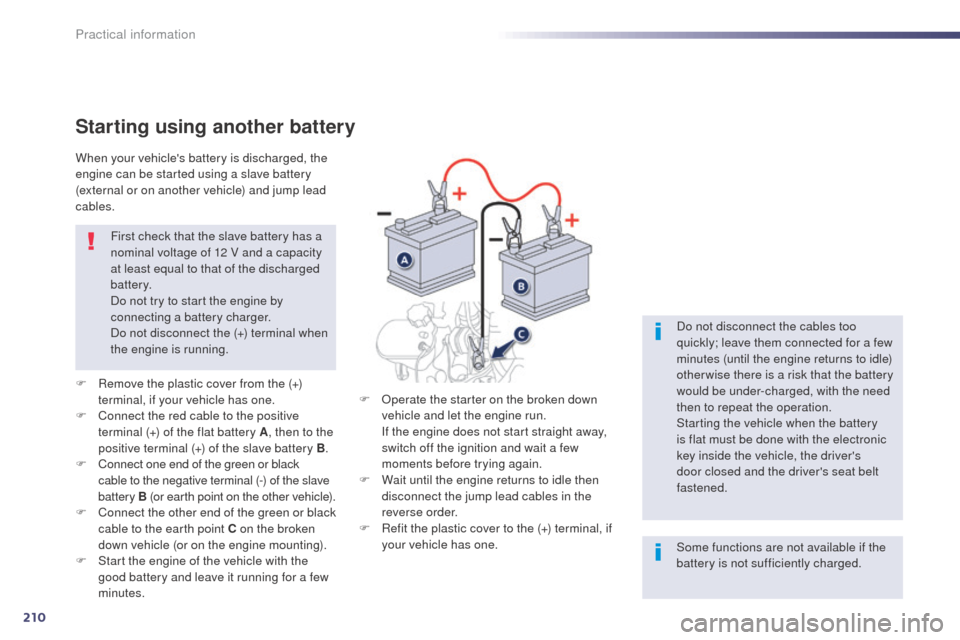
210
508RXH_en_Chap08_info-pratiques_ed01-2014
Starting using another battery
F Remove the plastic cover from the (+) terminal, if your vehicle has one.
F
C
onnect the red cable to the positive
terminal (+) of the flat battery A , then to the
positive terminal (+) of the slave battery B.
F
C
onnect one end of the green or black
cable to the negative terminal (-) of the slave
battery B (or earth point on the other vehicle).
F
C
onnect the other end of the green or black
cable to the earth point C on the broken
down vehicle (or on the engine mounting).
F
S
tart the engine of the vehicle with the
good battery and leave it running for a few
minutes. First check that the slave battery has a
nominal voltage of 12 V and a capacity
at least equal to that of the discharged
battery.
Do not try to start the engine by
connecting a battery charger.
Do not disconnect the (+) terminal when
the engine is running.
When your vehicle's battery is discharged, the
engine can be started using a slave battery
(external or on another vehicle) and jump lead
cables.
F O perate the starter on the broken down
vehicle and let the engine run.
I
f the engine does not start straight away,
switch off the ignition and wait a few
moments before trying again.
F
W
ait until the engine returns to idle then
disconnect the jump lead cables in the
reverse order.
F
R
efit the plastic cover to the (+) terminal, if
your vehicle has one. Do not disconnect the cables too
quickly; leave them connected for a few
minutes (until the engine returns to idle)
otherwise there is a risk that the battery
would be under-charged, with the need
then to repeat the operation.
Starting the vehicle when the battery
is flat must be done with the electronic
key inside the vehicle, the driver's
door closed and the driver's seat belt
fastened.
Some functions are not available if the
battery is not sufficiently charged.
Practical information
Page 213 of 338
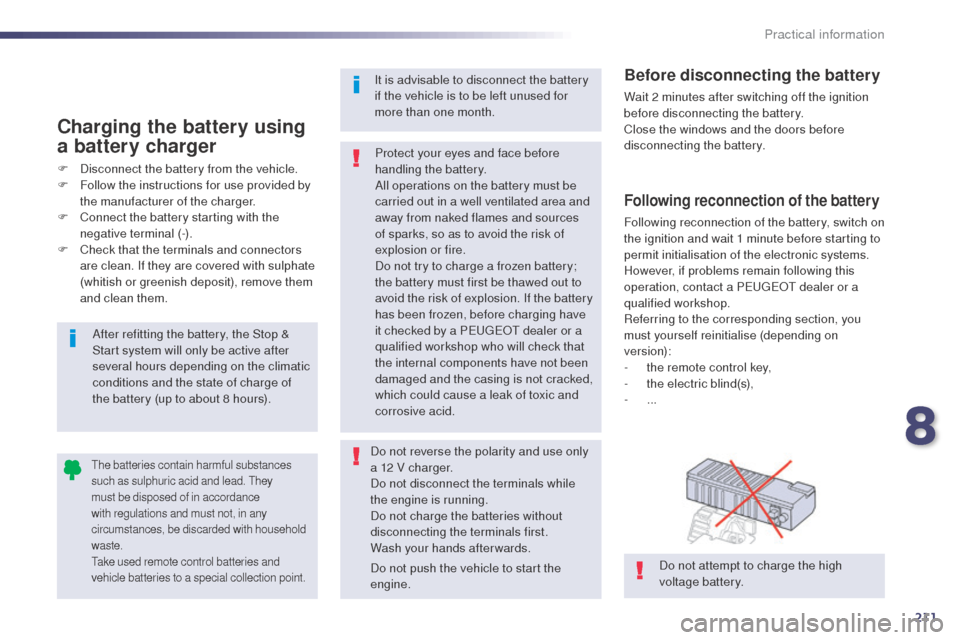
211
508RXH_en_Chap08_info-pratiques_ed01-2014
Following reconnection of the battery
Following reconnection of the battery, switch on
the ignition and wait 1 minute before starting to
permit initialisation of the electronic systems.
However, if problems remain following this
operation, contact a P
e
uge
Ot
dealer or a
qualified workshop.
Referring to the corresponding section, you
must yourself reinitialise (depending on
version):
-
t
he remote control key,
-
t
he electric blind(s),
-
...
Before disconnecting the battery
Wait 2 minutes after switching off the ignition
before disconnecting the battery.
Close the windows and the doors before
disconnecting the battery.
Protect your eyes and face before
handling the battery.
All operations on the battery must be
carried out in a well ventilated area and
away from naked flames and sources
of sparks, so as to avoid the risk of
explosion or fire.
Do not try to charge a frozen battery;
the battery must first be thawed out to
avoid the risk of explosion. If the battery
has been frozen, before charging have
it checked by a P
e
uge
Ot
dealer or a
qualified workshop who will check that
the internal components have not been
damaged and the casing is not cracked,
which could cause a leak of toxic and
corrosive acid.
Do not push the vehicle to start the
engine. It is advisable to disconnect the battery
if the vehicle is to be left unused for
more than one month.
the batteries contain harmful substances
such as sulphuric acid and lead.
th ey
must be disposed of in accordance
with regulations and must not, in any
circumstances, be discarded with household
waste.
ta
ke used remote control batteries and
vehicle batteries to a special collection point.
Do not attempt to charge the high
voltage battery.
After refitting the battery, the Stop &
Start system will only be active after
several hours depending on the climatic
conditions and the state of charge of
the battery (up to about 8 hours).
Charging the battery using
a battery charger
F Disconnect the battery from the vehicle.
F
F ollow the instructions for use provided by
the manufacturer of the charger.
F
C
onnect the battery starting with the
negative terminal (-).
F
C
heck that the terminals and connectors
are clean. If they are covered with sulphate
(whitish or greenish deposit), remove them
and clean them.
Do not reverse the polarity and use only
a 12 V charger.
Do not disconnect the terminals while
the engine is running.
Do not charge the batteries without
disconnecting the terminals first.
Wash your hands afterwards.
8
Practical information
Page 214 of 338
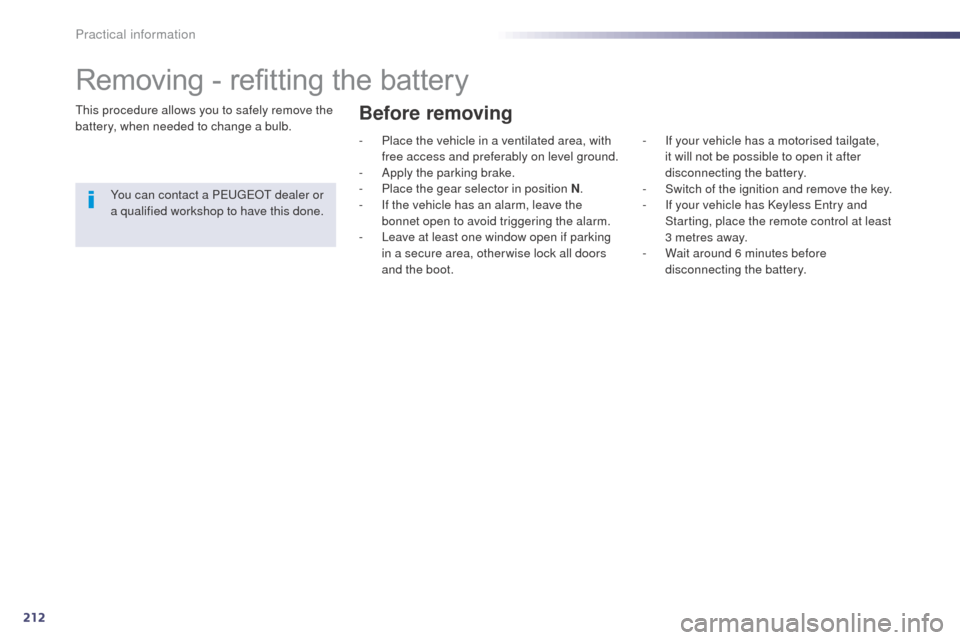
212
508RXH_en_Chap08_info-pratiques_ed01-2014
Removing - refitting the battery
this procedure allows you to safely remove the
battery, when needed to change a bulb.You can contact a P
e
uge
Ot
dealer or
a qualified workshop to have this done.Before removing
- If your vehicle has a motorised tailgate, it will not be possible to open it after
disconnecting the battery.
-
S
witch of the ignition and remove the key.
-
I
f your vehicle has Keyless e
n
try and
Starting, place the remote control at least
3 metres away.
-
W
ait around 6 minutes before
disconnecting the battery.
-
P
lace the vehicle in a ventilated area, with
free access and preferably on level ground.
-
A
pply the parking brake.
-
P
lace the gear selector in position N .
-
I
f the vehicle has an alarm, leave the
bonnet open to avoid triggering the alarm.
-
L
eave at least one window open if parking
in a secure area, other wise lock all doors
and the boot.
Practical information
Page 215 of 338
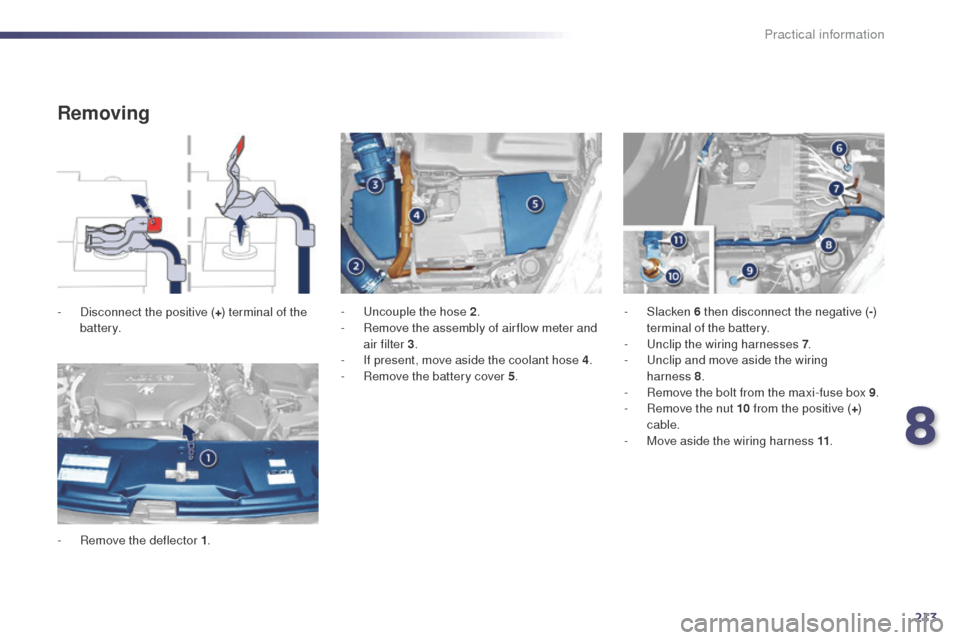
213
508RXH_en_Chap08_info-pratiques_ed01-2014
Removing
- Disconnect the positive (+) terminal of the
battery.
-
R
emove the deflector 1 . -
un couple the hose 2
.
- R emove the assembly of air flow meter and
air filter 3 .
-
I
f present, move aside the coolant hose 4.
-
R
emove the battery cover 5.-
Slacken
6 then disconnect the negative ( -)
terminal of the battery.
-
u
nc
lip the wiring harnesses 7.
-
u
n
clip and move aside the wiring
harness
8.
-
R
emove the bolt from the maxi-fuse box 9.
-
R
emove the nut 10 from the positive ( +)
cable.
-
M
ove aside the wiring harness 11.
8
Practical information
Page 216 of 338
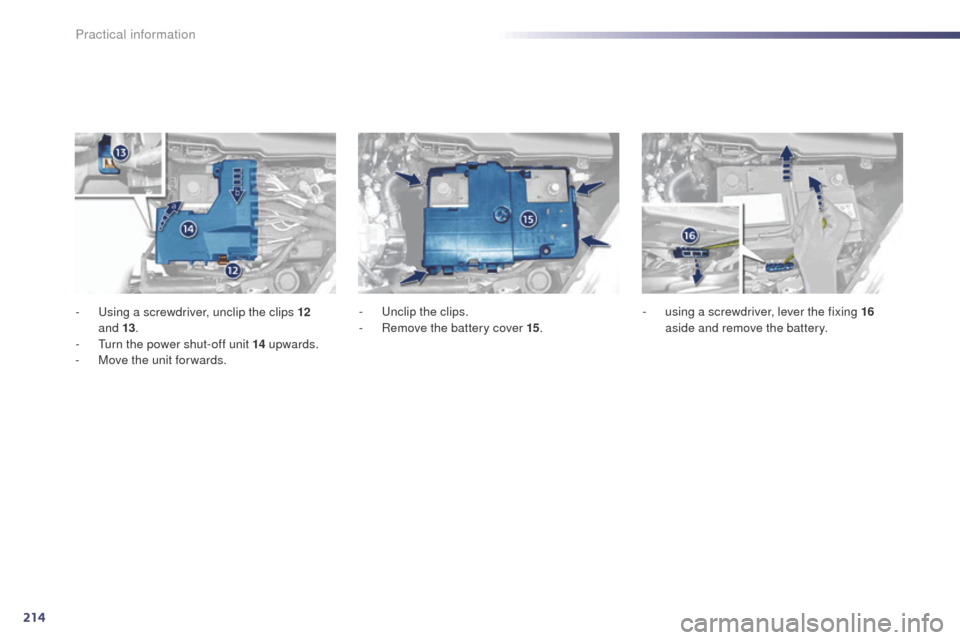
214
508RXH_en_Chap08_info-pratiques_ed01-2014
- using a screwdriver, unclip the clips 12
and 13.
-
t
u
rn the power shut-off unit 14 upwards.
-
M
ove the unit for wards. -
un clip the clips.
- R emove the battery cover 15.-
u sing a screwdriver, lever the fixing 16
aside and remove the battery.
Practical information
Page 217 of 338
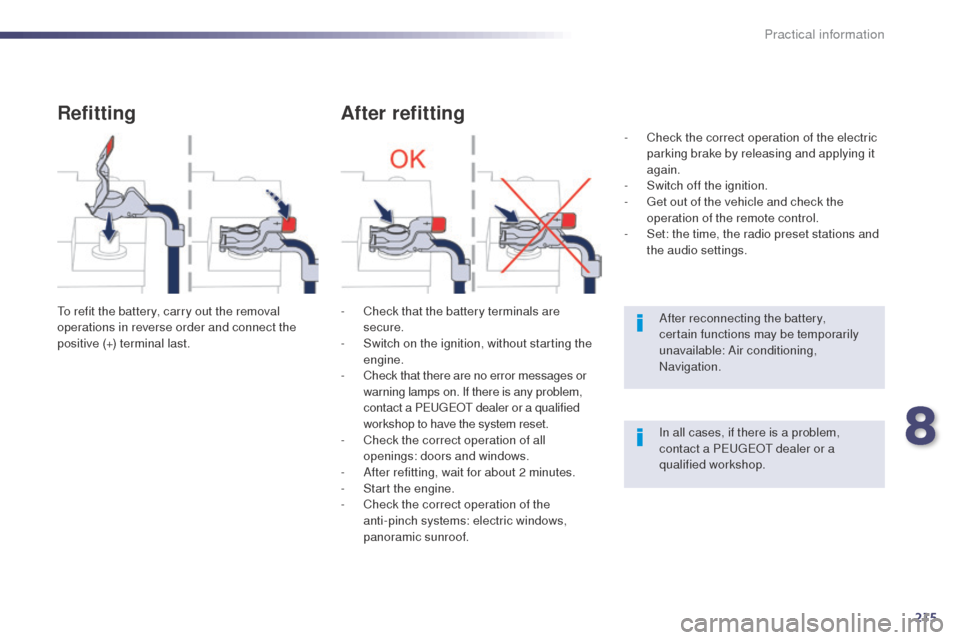
215
508RXH_en_Chap08_info-pratiques_ed01-2014
Refitting
to refit the battery, carry out the removal
operations in reverse order and connect the
positive (+) terminal last.
After refitting
- Check that the battery terminals are secure.
-
S
witch on the ignition, without starting the
engine.
-
C
heck that there are no error messages or
warning lamps on. If there is any problem,
contact a P
e
uge
Ot
dealer or a qualified
workshop to have the system reset.
-
C
heck the correct operation of all
openings: doors and windows.
-
A
fter refitting, wait for about 2 minutes.
-
S
tart the engine.
-
C
heck the correct operation of the
anti-pinch systems: electric windows,
panoramic sunroof. After reconnecting the battery,
certain functions may be temporarily
unavailable: Air conditioning,
Navigation.
In all cases, if there is a problem,
contact a P
e
uge
Ot
dealer or a
qualified workshop.
-
C
heck the correct operation of the electric
parking brake by releasing and applying it
again.
-
S
witch off the ignition.
- g
e
t out of the vehicle and check the
operation of the remote control.
-
S
et: the time, the radio preset stations and
the audio settings.
8
Practical information
Page 218 of 338
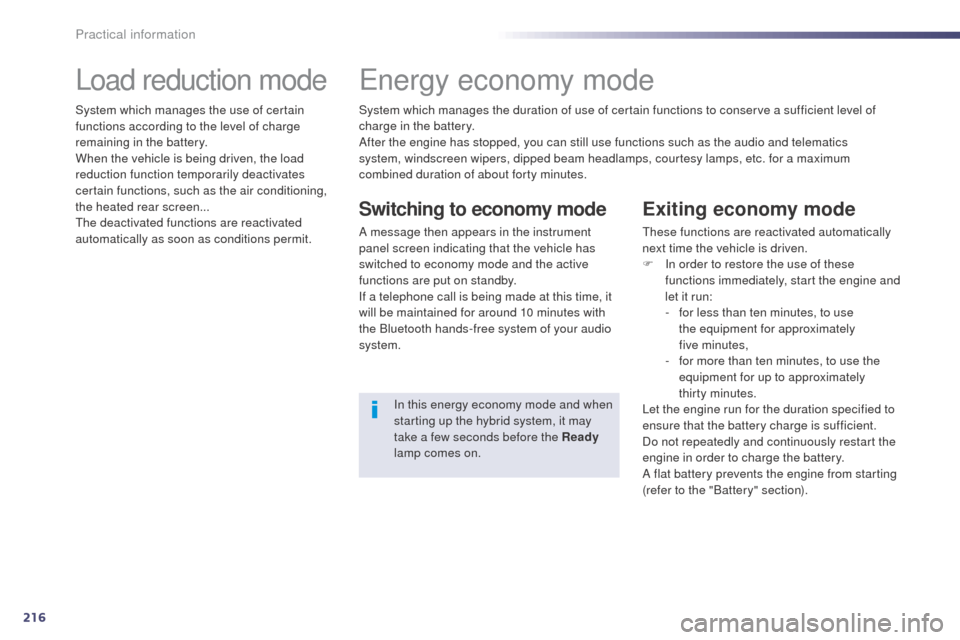
216
508RXH_en_Chap08_info-pratiques_ed01-2014
Load reduction mode
System which manages the use of certain
functions according to the level of charge
remaining in the battery.
When the vehicle is being driven, the load
reduction function temporarily deactivates
certain functions, such as the air conditioning,
the heated rear screen...
th
e deactivated functions are reactivated
automatically as soon as conditions permit. System which manages the duration of use of certain functions to conserve a sufficient level of
charge in the battery.
After the engine has stopped, you can still use functions such as the audio and telematics
system,
windscreen wipers, dipped beam headlamps, courtesy lamps, etc. for a maximum
combined duration of about forty minutes.
energy economy mode
Switching to economy mode
A message then appears in the instrument
panel screen indicating that the vehicle has
switched to economy mode and the active
functions are put on standby.
If a telephone call is being made at this time, it
will be maintained for around 10 minutes with
the Bluetooth hands-free system of your audio
system.
Exiting economy mode
these functions are reactivated automatically
next time the vehicle is driven.
F
I
n order to restore the use of these
functions immediately, start the engine and
let it run:
-
f
or less than ten minutes, to use
the equipment for approximately
five
minutes,
-
f
or more than ten minutes, to use the
equipment for up to approximately
thirty
minutes.
Let the engine run for the duration specified to
ensure that the battery charge is sufficient.
Do not repeatedly and continuously restart the
engine in order to charge the battery.
A flat battery prevents the engine from starting
(refer to the "Battery" section).
In this energy economy mode and when
starting up the hybrid system, it may
take a few seconds before the Ready
lamp comes on.
Practical information
Page 219 of 338
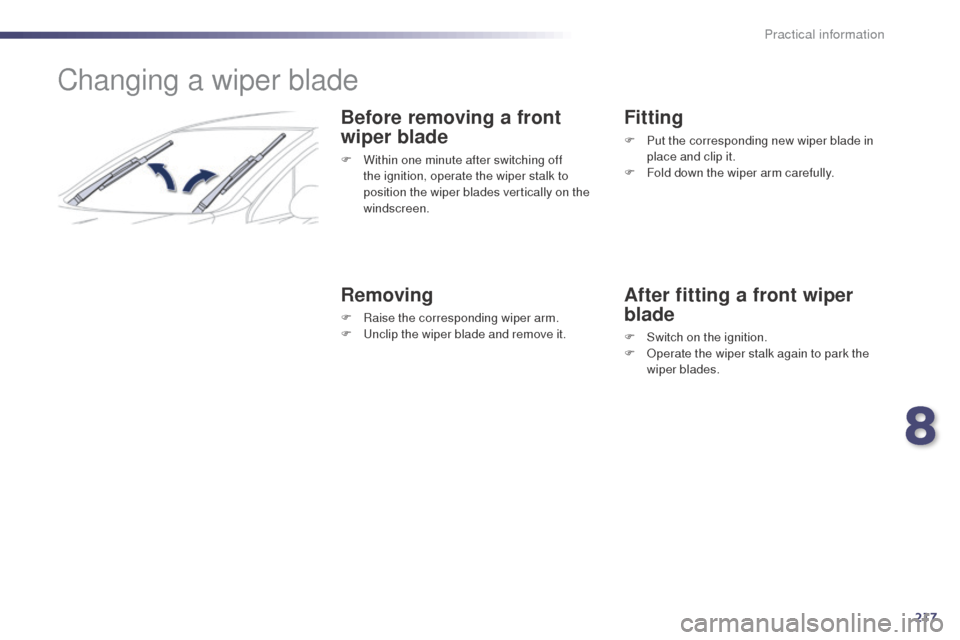
217
508RXH_en_Chap08_info-pratiques_ed01-2014
Changing a wiper blade
Before removing a front
wiper blade
F Within one minute after switching off the ignition, operate the wiper stalk to
position the wiper blades vertically on the
windscreen.
Removing
F Raise the corresponding wiper arm.
F un clip the wiper blade and remove it.
Fitting
F Put the corresponding new wiper blade in place and clip it.
F
F
old down the wiper arm carefully.
After fitting a front wiper
blade
F Switch on the ignition.
F O perate the wiper stalk again to park the
wiper blades.
8
Practical information
Page 220 of 338
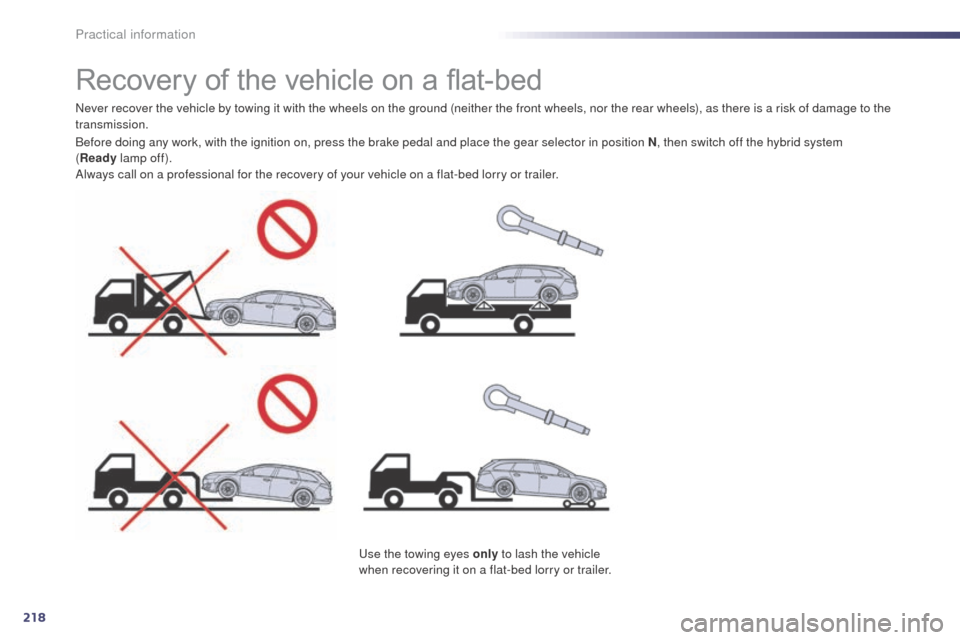
218
508RXH_en_Chap08_info-pratiques_ed01-2014
Recovery of the vehicle on a flat-bed
Never recover the vehicle by towing it with the wheels on the ground (neither the front wheels, nor the rear wheels), as there is a risk of damage to the
transmission.
Before doing any work, with the ignition on, press the brake pedal and place the gear selector in position N, then switch off the hybrid system
( Ready
lamp off).
Always call on a professional for the recovery of your vehicle on a flat-bed lorry or trailer.
us
e the towing eyes only to lash the vehicle
when recovering it on a flat-bed lorry or trailer.
Practical information